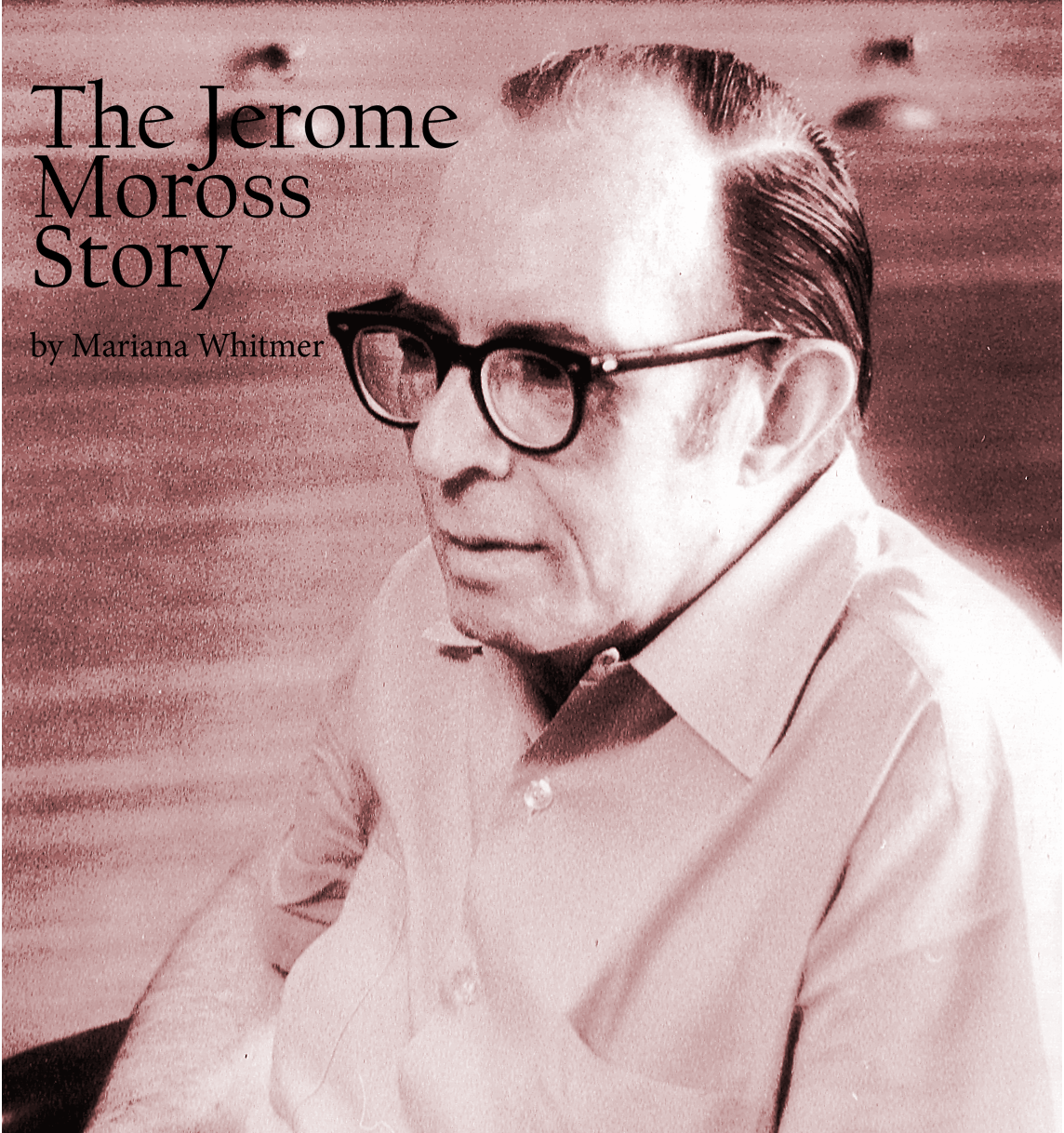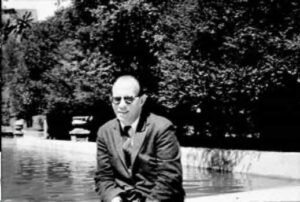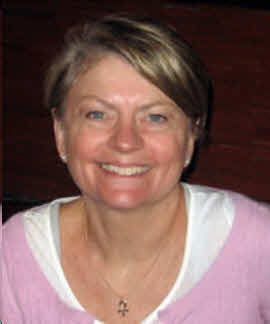JEROME MOROSS’s career encompasses four spheres, Broadway, Hollywood, the Dance world and the concert hall. He is best known to some audiences as the composer of the Academy Award-nominated score for William Wyler’s epic western, The Big Country (1958). An innovative score that challenged the status quo, it has influenced Western film scores ever since. Yet Moross also influenced the theatrical world with his unique approach to musical theater, including The Golden Apple (1954) and his interpretation of American urban mythology in Frankie and Johnny (1938), a work that combined American music and vernacular dance. Certain of Moross’s compositions that lack a dramatic core are less appreciated, but even his instrumental pieces have a story to tell. Moross composed many important pieces that crossed genres and inspired a re-consideration of traditional attitudes.
THE EARLY YEARS
JEROME MOROSS was born in Brooklyn on August 1, 1913, into a family of émigrés from Russia, one of many who settled in the ethnic neighborhoods of New York’s Lower East Side and started businesses in the early years of the twentieth century. Moross quickly established his intellectual and musical talents, playing the piano from the age of five and composing when he was eight. As a teenager, Moross became friends with Bernard Herrmann (1911-1975), who would also distinguish himself as an important composer, and the two listened to or played as much modern repertoire as they could find. Moross first encountered Herrmann when he was 14 years old, and described the event in a later interview:
We were in a German class, and I was sitting in the back of the room so the teacher shouldn’t disturb me while I was composing, and I looked up and I saw a boy sitting across the aisle, twirling his hair and studying the Mahler Fifth Symphony in a Eulenberg miniature score. . . . He looked at me, and he said “Do you know Mahler?” and I said, “Mahler stinks” or something like that . . . He got quite angry and grabbed what I was writing, looked at it, tossed it back at me, and said, “Dishwater Tchaikovsky!”[i]
Thus began a friendship that lasted until Herrmann’s death as Moross and Herrmann pursued their love of music together. They performed each other’s compositions, and eventually formed a trio with Hermann’s young brother, Louis, who played the cello. Together the three sought paying engagements wherever possible, in jazz bands, at dances and in theater pits. Moross also composed incidental music for what he described as “the equivalent of off-Broadway plays.”[ii] Moross reflected on their relationship, “An almost brotherly closeness existed for years until, frankly, I felt I had to break out from under his grasp. But whenever we met again the old bonds were renewed with the first greeting.”[iii]
THE 30'S
New York City in the early 1930s was an exciting place and Moross took advantage of all the musical attractions it offered. One of his favorites was Harms Music Publishers where, as Moross recalled, “You met people,” and this could include anyone from Oscar Levant (1906-1972) to [Robert] Russell Bennet (1894-1981), and Vince Youmans to Vernon Duke (ne Vladimir Dukelsky, (1903-1969). T. B. Harms, founded in 1875, was the largest publisher of popular music in New York City at the time and handled the publication of several important American composers. Their compositions impressed Moross tremendously. “The songs were so extraordinary,” he later remarked, citing specifically Duke’s “April in Paris” (1932), “Suddenly (1933), and “Autumn in New York” (1934). Moross’s appreciation for their work would draw him to the theater, where he would combine his talent for lyrical melodies with larger formal constructions. Many years later Moross reflected, “Popular music has fallen into the hands of the amateurs, and you don’t get those gorgeous songs anymore.”[iv]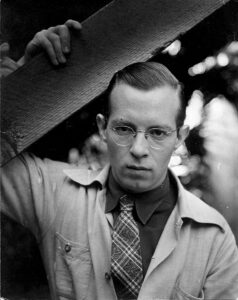
Moross as a young man
In the air there was a great deal of enthusiasm for change, influencing not only popular music in the clubs and dance halls, but in the theater and concert halls. Moross and Herrmann also became acquainted with Henry Cowell (1897-1965) who introduced them to Charles Ives (1874-1954). They became acquainted with Ives’s music by working through the Concord Sonata and became great champions of Ives’s works. “I remember arguing with Aaron Copland that he must play Ives when he was going to run his Yaddo Festival [of Contemporary Music at Yaddo, Saratoga Springs, in 1931] and I gave him my copy of the 114 Songs.” Moross visited Ives regularly for several years, and the influence of Ives is evident throughout his compositions. Moross graduated from New York University in 1931 when he was only 18. During his senior year he simultaneously attended The Juilliard School as a conducting fellow. Moross generally felt that he did not need formal composition lessons, concluding that his musical education was perhaps best served by his experiences outside the classroom. “I had harmony, fugue, form, everything else. All the grammar you needed. But I always felt that I didn’t want to learn how somebody else writes. All he can do is show me how he writes. Besides, by the time I entered Juilliard I was already composing, and I felt that I was pretty good. . . . I did have a complete grounding in musical techniques. And I had already been playing in pit orchestras, so that I knew my orchestra inside out. So that was my training.” Moross was indeed composing. Paeans (1931), his first work, was conducted by Bernard Herrmann when it premiered in the Juilliard concert hall, and was published by Henry Cowell in his New Music Orchestra Series. Clearly influenced by the modernists, it features abundant dissonances, and at one point, quarter tones. Moross met Aaron Copland in 1931 and was invited to join Copland’s Young Composers’ Group, which included Herrmann, along with Elie Siegmeister, Arthur Berger, Lehman Engel, and Vivian Fine, among others. Through the group Moross became acquainted with other well-known composers and performers. Together they planned concerts and performed one another’s music. In a 1936 article Copland wrote, “Moross is probably the most talented of these men. He writes music that has a quality of sheer physicalness, music ‘without a mind,’ as it were.”[vii] Copland supported Moross’s work, recommending him to Ruth Page,[viii] for instance, and their careers would occasionally intersect, particularly in Hollywood. Moross’s next composition, Two Songs (“Jabberwocky” and “Those Gambler’s Blues” for low voice with piano), was performed at the first concert of the Young Composers Group held in 1933.
COAST-TO-COAST
Moross did not remain in New York, however, and the return to California, precipitated by financial necessity, became an extended stay (from 1940-1945). Married in August of 1939 to Hazel Abrams, Moross related, “We discovered we were going to be parents, and we had no money. The March of Time had shut down. So we hot-footed out to the coast.”[xv] When he first moved to Hollywood, Moross could not get any work. As he recalled, “I was considered too radical at the time.”[xvi] It was Aaron Copland’s score for Our Town that gave Moross his first big break in February 1940 when he was hired to orchestrate it. This initial job established Moross’s career as a capable orchestrator, setting him on a professional trajectory that eventually led to more fame than he possibly would have achieved without it.
After Our Town, other work came sporadically but the income from orchestrating provided him with the means to continue composing his own works. In 1940 he assisted with Adolph Deutsch’s score for They Drive by Night, a film starring Humphrey Bogart. This film introduced Moross to Leo Forbstein (1892-1948) and the Warner Bros. studio, which would presently lead to a full-time position. His co-orchestrators were Hugo Friedhofer (1901-1981) and Arthur Lange (1889-1956), both of whom Moross would work with on subsequent films. In 1941 he assisted in the orchestration of the David Buttolph and Cyril Mockridge score for Scotland Yard. This film marks the first time that Moross worked with Emil Newman (1911-1984), who was the musical director for this Twentieth Century Fox production.
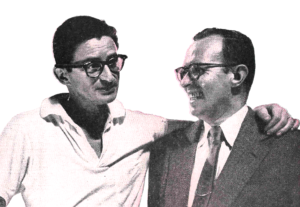
With Emil Newman
Moross worked for Warner Bros. until 1945, and he generally enjoyed his experiences as a studio arranger. Although he was typically assigned to work with specific composers, he also orchestrated films for others. For example, in 1943 he helped orchestrate another of Aaron Copland’s scores, The North Star (1943), a project that introduced Moross to Samuel Goldwyn (1879-1974), for whom he eventually orchestrated five films. In addition, Moross recalled being loaned to Max Steiner to help with a score that was behind schedule. Although he had forgotten the name of the film, it was certainly Since You Went Away (1944), a David O. Selznick production for which he was not credited. During this time Moross worked on 26 films as either orchestrator or arranger, although for many of these he remained uncredited. This was not unusual in the years of the studio system where the orchestrators were little more than clerks, and credits were typically limited to the main cast and crew.
During this time Moross continued his development of dramatic compositions with Ballet Ballads, a set of four short works composed between 1941 and 1946, although not performed together until 1948. With lyrics by John Latouche (1914-1956) each piece presents an unconventional adaptation of well-known narratives. “Susanna and the Elders” is the biblical story set as a revivalist camp meeting; “Willie the Weeper” and “The Eccentricities of Davy Crockett” present the well-known urban and rural (respectively) American folk tales; and “Riding Hood Revisited: Simple Symphony in E Flat Major” is a provocatively updated version of the story, which would later be orchestrated as Variations on a Waltz.
While in Hollywood, Moross was able to have some of his own music performed. “Susanna and the Elders” was given its premier performance as a concert work (Moross referred to it as an oratorio) on March 9, 1941, by the Hollywood Theatre Alliance with Alfred Newman conducting. Biguine was performed in 1944 at one of Franz Waxman’s Symphony Under the Stars concerts at the Hollywood Bowl. In November of the same year, the Los Angeles Philharmonic included Moross’s Symphony No. 1 in the opening concert of the season conducted by Alfred Wallenstein (1898-1983).
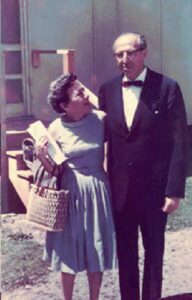
Hazel with Aaron Copland
In 1945 the Ballet Russe de Monte Carlo purchased Frankie and Johnny and the promise of a performance prompted the Moross family to return to New York City. This production was given The New York Times Award for Best Ballet of the 1945 Season. As Moross became more focused on his own compositions he left Warner Bros. and returned to Los Angeles only when there was an interesting project or financial necessity. Subsequent trips were made to work with Friedhofer on the award-winning The Best Years of Our Lives (1946), a project that led to three more such collaborations including the popular The Bishop’s Wife (1947).
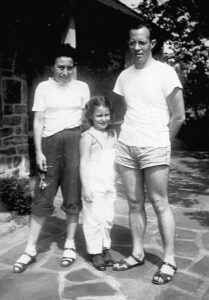
With Hazel and Susanna
In 1947 and 1949 Moross was awarded Guggenheim Fellowships to support the composition of a major new work, a second collaboration between Moross and Latouche. Like Ballet Ballads, this piece for musical theater was similarly unconventional, yet highly successful. The Golden Apple (1948-1950) is a re-telling of The Iliad and The Odyssey set in Washington State at the end of the Spanish-American War. It was first performed in 1954, when it ran for almost 200 performances and received the New York Drama Critics Circle Award for Best Musical of the 1953-1954 Season. As in an opera, recitatives, arias (songs), and ensembles (without any dialogue) characterize the work, but the musical numbers are cast in a popular style. Explaining the importance of this collaboration between Moross and Latouche, Mark Grant in The Rise and Fall of the Broadway Musical, describes how they “laid out in embryo the future course of the mega-commodified Broadway musical. In their refusal to follow the music-dialogue-lyrics pattern practice [of] Rodgers and Hammerstein-style Broadway, and in their substituting a totally sung libretto animated by narrative dancing, every element of the commercial musical of later decades can be found; the through-sung cantatas of Lloyd Webber and others; the director-choreographer shows; [and] the “dansicals” such as Bob Fee’s Big Deal.[xvii] The Golden Apple was most recently revived in 1990. Barbra Streisand, Tony Bennett, Sarah Vaughan, and Wynton Marsalis, among others, have recorded “Lazy Afternoon,” one of the songs from the work.
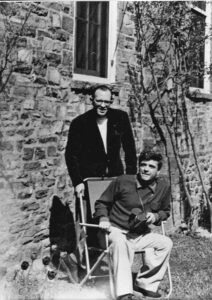
With John Latouche
On May 9, 1948, Moross’s Ballet Ballads, including “Susanna and the Elders,” “Willie the Weeper” and “The Eccentricities of Davy Crockett,” opened at the Maxine Elliott Theatre, produced by the Experimental Theatre, which was only in its second season. It played for four days and then moved to the Music Box Theatre on Broadway, on May 16, where it played for several weeks. By the time it closed on July 10, Moross was back in Hollywood working with Friedhofer on Joan of Arc (1948).
By the time Joan of Arc was released, Moross was already embarking on his own career of composing original scores. Moross’s first two original film scores, Close-Up (1948) and When I Grow Up (1951), were made in New York City for Eagle-Lion Films. Close-Up, a post-war film noir, was Moross’s only attempt at scoring in that genre, and the music features a lush sound, more in the realm of the European romantics than the American modernists. Moross returned to Hollywood a little less than a year later to orchestrate Roseanna McCoy (1949) with a score by David Buttolph, and while he was there he took advantage of his contacts and acquaintances to organize a west coast production of Ballet Ballads. On October 5, 1950, “Susanna and the Elders,” “Willie the Weeper and “The Eccentricities of Davy Crockett” opened at the Century Theater in Los Angeles. The show played for several weeks before closing toward the end of November.
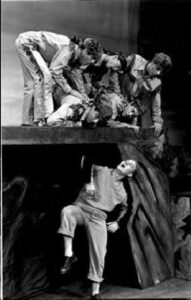
Scene from The Eccentricities of Davy Crockett
Moross in Italy
While most of Moross’s creative interest was focused on dramatic composition (including theater, ballet, and film), in the mid-1960s Moross turned to orchestrations and adaptation of previous works, which inspired him to write new instrumental pieces. An arrangement of his favorite cues from the film scores resulted in the work, Music for the Flicks (1965), including music from The Cardinal, The Proud Rebel, Five Finger Exercise, The Sharkfighters and The War Lord. In 1966, CBS commissioned Moross to orchestrate Ballet Ballads for a television broadcast that never occurred, including Riding Hood Revisited, which became Variations on a Waltz.
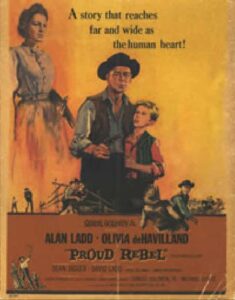
Poster for The Proud Rebel
THE FINAL YEARS: CLASSICAL LEGACY
In a 1979 interview Moross remarked that he was at work on a second symphony, and a quantity of extant sketches attest to this. However, his last compositions are for chamber works. Moross’s last two works are scored for string quartets: Sonata for Piano Duet and String Quartet (1975) and Concerto for Flute with String Quartet (1978). Moross was excited about his final instrumental works, sensing that audiences would appreciate his new sound. As he described his music, “It uses classical grammar and makes modern music with it. . . . It writes music that an audience will like, will listen to; not because I want to just coddle the audience, but because that’s the way I feel.”[xxiii] Indeed, this was an approach that Moross adhered to throughout his entire career, music that utilizes traditional modes and infuses them with popular American idioms.
Moross returned to dramatic composition once more, composing a single one-act opera, Sorry, Wrong Number (1977), based on the radio play (1943) and later film (1948) by Lucille Fletcher, the former wife of Bernard Herrmann. Moross once commented that it had always been his intent to “change the theatre” to make it operatic, and he cited The Golden Apple as the premiere example. Acknowledging that his attempt may have been unsuccessful, and that “The theatre doesn’t want me. . . .” Moross decided to move into “pure opera.” With Sorry, Wrong Number, Moross ventured into unfamiliar territory by setting prose to music for the first time. As he later noted, “[Fletcher’s] prose is beautifully done and it allowed me to even get ariettas throughout the thing. I trained myself for the first time to write to prose, and now I’m no longer afraid of trying to get a play and turning it into an opera.”[xxiv] First premiered in 1977, it was performed again in 1980 and 1982.
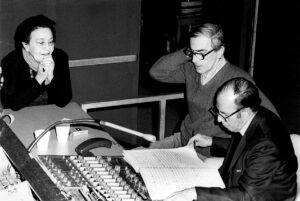
Working on the recording of Concerto for Flute and String Quartet
While the soundtracks to his film scores, especially The Big Country, continue to sell, interest in Moross’s dramatic and instrumental works is increasing. Notably, there have been recent performances of his ballets, including An American Pattern in 2000 by the Hot Springs Symphony Orchestra, an ensemble that has recorded several of Moross’s works. The York Theater Company in New York revived The Golden Apple in 1990, and a new edition was published in 2003, incorporating Moross’s revisions made in 1977. Since 1998, Frankie and Johnny has been performed four times. Scholarly appreciation of Moross is also growing with a new study of the score for The Big Country as well as analyses of his stage works.
REFERENCES
i Jerome Moross, interview by Craig Reardon, April 16, 1979. For a complete transcription of Moross’s recollection of this event, see A Heart at Fire’s Center: The Life and Music of Bernard Herrmann by Steven C. Smith (Los Angeles: University of California Press, 1991).
ii Interview by Craig Reardon.
iii Jerome Moross to Christopher Palmer, February 17, 1976, Jerome Moross Papers. Rare Book and Manuscript Library, Columbia University.
iiii Interview by Craig Reardon, op. cit.
v Vivian Perlis, Charles Ives Remembered: An Oral History (New Haven: Yale University Press, 1974).
vi Jerome Moross, interview by John Caps, August 31, 1979.
vii Aaron Copland, Copland on Music (Garden City, NY: Doubleday, 1960), 161.
viii Moross’s ballet, An American Pattern, would come directly after Copland’s Hear Ye! Hear Ye!
ix Moross’s grandson, Joshua, interviewed his great-uncle Charlie, who related the story of a time that the composer took him to Coney Island just to hear a carousel.
x Lawrence Morton, “Jerome Moross: Young Man Goes Native,” Modern Music 22, 2 (1945), 111-114.
xi Jerome Moross to Christopher Palmer, March 22, 1973. Private Collection of Susanna Moross Tarjan.
xii Jerome Moross, interview by Paul Snook for WRVR Radio, 1970.
xiii Jerome Moross to William Fitelson, August 13, 1944. Jerome Moross Papers.
xiv Carl Sandburg, The American Songbag (New York: Harcourt, Brace & World, 1940), 75.
xv Interview by Craig Reardon, op cit.
xvi Jerome Moross to Christopher Palmer, July 19, 1972. Jerome Moross Papers.
xvii Mark N. Grant, The Rise and Fall of the Broadway Musical (Boston, MA: Northeastern University Press, 2004), 109-110
xviii Jerome Moross to Hazel, Tuesday, January 23 [1952]. Jerome Moross Papers.
xix Interview by John Caps, op. cit.
xx Interview by Paul Snook, op cit.
xxi Windflowers: The Songs of Jerome Moross. PS Classics [2001], CD (rec. April 2000)
xxii Jerome Moross, liner notes to “Sonatina for Brass Quintet,” Pro Musica of London; David Katz, director; John Wilbraham, Laurie Evans, trumpets; Nicholas Busch, horn; Roger Brenner, trombone; John Jenkins, tuba. Desto DC-6469 [1972], LP. Quoted in Charles Turner, “Jerome Moross: An Introduction and Annotated Worklist,” Notes: Quarterly Journal of the Music Library Association 61, no. 3 (2005), 692.
xxiii Interview by John Caps, op. cit.
xxiv Ibid.
ABOUT THE AUTHOR: MARIANA WHITMER
Author, scholar, and Executive Director of the Society for American Music
Visit: MarianaWhitmer.com
Mariana Whitmer is Executive Director of the Society for American Music and directs special projects at the Center for American Music at the University of Pittsburgh, where she also teaches a course on music and film. She has contributed essays to Music in the Western (edited by K. Kalinak, Routledge, 2010) and Anxiety Muted: American Film Music in a Suburban Age (edited by Stanley Pelkey and Anthony Bushard, Oxford University Press, forthcoming). Dr. Whitmer recently completed Film Score Guide on The Big Country (Scarecrow Press, 2012), and is currently working on a monograph about the classic Hollywood Western. In addition to continued work on a comprehensive biography on Jerome Moross, she is currently finishing a research article tentatively titled “Jerome Moross’s Ballet Ballads” and the “Creation of a ‘Free Dramatic Dynamism.’”
